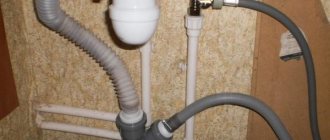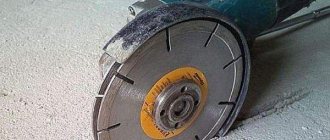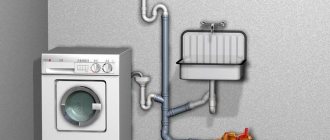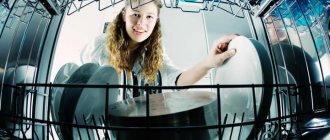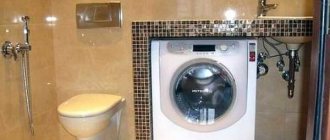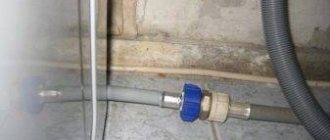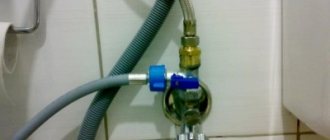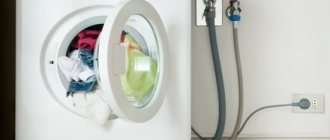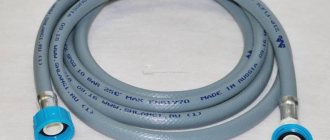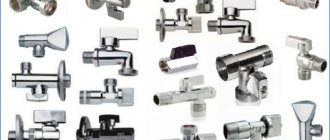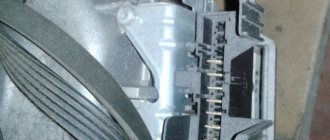Hard water with rust or dirt is the main enemy of modern household appliances.
More than half of all heating element breakdowns are caused by bad water, so special filters are used to protect washing machines and other expensive equipment.
Most machines have a pre-installed coarse filter that traps hair, threads, buttons and other large debris, but it is not able to cope with small particles.
That is why it is recommended to install an additional filter for the washing machine in case of bad rusty water.
First of all, it will help eliminate mechanical impurities that clog the internal filter, which reduce the pressure and ultimately lead to the machine stopping taking in water.
Water with rust and sand significantly reduces the service life of the water drain pump. In addition, the quality of washing noticeably deteriorates, because the dirtier the water, the worse the washing results will be.
Installing a filter, although expensive, is a completely economically justified solution, since any breakdown of this equipment will result in significant repair costs.
Installation of a washing machine, where is it better to install.
It’s hard to imagine a modern housewife who gets rid of stains on her laundry on a washboard.
The automatic machine has replaced women’s hands and copes with the task much faster and more efficiently. You can safely connect the washing machine to the water supply yourself. For this technique, a certain, specially prepared area is allocated, which occupies a significant part of the living space. Where to install the washing machine
Washing machine in the kitchen area
Installing a washing machine in the kitchen is common and relevant. This distribution is due to technical parameters that make it possible to simplify the connection without additional laying of water supply and drainage pipes.
Besides:
- more space than in the bathroom;
- less destructive moisture;
- in the kitchen it is easier to connect to the power supply;
- the ability to create a separate area for electrical appliances to make it easier to do everyday life and have everything “at your fingertips”;
- the surface of the washing machine can be used effectively, for example, it can be equipped with a place for an electric kettle and a microwave oven;
- The washing process will not interfere with water procedures.
Washing machine in the kitchen under the countertop
In addition to advantages, there are also disadvantages. Washing involves the use of a number of chemicals that are harsh and can cause significant damage to the body. Therefore, all chemicals should be kept separately and away from food.
Installing a washing machine in the bathroom
Placing a washing machine in the bathroom is a classic option. Among the advantages of installation in this area are:
- in the bathroom, the floor often has enhanced waterproofing, which will avoid conflict with neighbors in the event of a water leak due to equipment breakdown;
- The close proximity to the bath allows, if necessary, to soak the laundry and easily transfer it to the washing machine or, conversely, remove it and wring it out manually.
- Chemicals and the accumulation of laundry waiting to be washed fit more harmoniously into the interior of the bathroom.
Washing machine in the bathroom
If there is no free space, you can plan installation under the sink or purchase a combined set, machine + sink.
In any case, the installation location is selected before the automatic assistant is purchased, and the washing machine model is selected to fit the dimensions of the installation location.
How to install it yourself
The filter installation algorithm depends on its type:
- Mainline. It is installed after the tap that turns off the water in the entire house. To do this, a hole is created in the pipe into which the device is inserted.
- Cleaning filter. Mounted directly in front of the washing machine. An outlet is made in the pipeline for the washing machine, then a filter device is installed. A washing machine is connected to it.
- Polyphosphate. It is mounted in the same way as the cleaning filter. Its dimensions are quite small, so installation should not cause any difficulties.
- Magnetic. To install it, there is no need to disassemble and redo communications. The filter is secured to the washing machine hose using bolts and a screwdriver.
See also
Rating of the 20 best freezers for the home and how to choose the right one
How to connect a washing machine to the water supply
Next we look at the possibility of connecting to the water supply. If you have access to any cold water tap, you can install a walk-through faucet for washing machines. The convenience of such a crane lies in the versatility of the solution. To do this, you can disassemble any connection (most often, this involves unscrewing the flexible hose, installing a faucet for the washing machine, and screwing the hose back on). One condition is that the pass-through valve must have an external thread on one side and an internal thread on the other. As a rule, this method is most often used in a toilet (or a combined bathroom), when there is access to a flexible supply line for the toilet, or there is access to a flexible supply line for the sink faucet. The thread diameter for the washing machine is the same and is 3/4 inch. It is best to seal the connection with Tangit Unilock thread. This method has only one drawback - the price, but otherwise, such sealing should be preferred to all other methods. You need to wind the thread in the direction of the thread, but not turn to turn, but randomly. The number of turns is indicated on the packaging for each pipe diameter. If you wind more, nothing bad will happen, the thread consumption will simply increase, but if less, the connection will leak. Then you simply disassemble, remove the old thread and wind a new one.
What to do if there is no access to a suitable connection, the pipelines are plastered, and there is only a bathroom faucet. Then a faucet kit with an extension is purchased (or an extension hose is fitted to an existing faucet) and installed as shown in the photo. Of course, this is not the most beautiful option, but what to do if during the renovation you did not provide for the possibility of connecting a washing machine. Such a kit may cost more than two taps, then it makes sense to simply install two taps. What subtlety here. As a rule, the mixer is installed through eccentrics. They are not always of good quality. Installing the eccentric first, then the washing machine faucet, then the mixer creates a very strong load on the eccentric (as shown in the picture), so I recommend following a different sequence: washing machine faucet→eccentric→faucet. So, we sorted out the joining.
There is another plumbing connection method that works for both metal and polypropylene pipes that does not require any skill in threading or soldering polypropylene pipes and is suitable if you have exposed pipes. For this, drainage is used. It consists of two halves that are attached to the pipe. Then a hole is drilled in the pipe and a tap is installed on the drainage system. I can’t say which method is better or worse, they are all good. Although it makes sense to use the last method only as a last resort. If it is possible to make a threaded connection or resolder a polypropylene pipe, it is better to do this than to use a drainage system.
Now all that remains is to screw the water supply hose onto the tap. In this case, there is no need to use sealing materials like FUM tape or thread - they will simply be useless. If you look closely, there is a rubber gasket on the fitting; it acts as a sealant. In this case, a seal must be ensured between the faucet flange and the inlet hose fitting flange. If you remove the gasket and apply a lot of sealant to the threads, water will leak between the flanges through the top of the nut, where there is no seal. We've sorted out the water - let's move on to the sewerage system.
Tasks of filtering water for washing
The machine has a regular mesh installed near the inlet hose, which catches coarse mechanical impurities, which is clearly not enough. This device is not intended for removing rust and small particles.
Additional filters can be installed:
- on the main line that supplies water to the entire apartment;
- on the water supply pipe to the washing machine.
The water filter is used for the following purposes:
- cleaning from impurities that clog the mesh in the machine and block the supply of incoming water;
- removal of rust, sand and other abrasive particles that cause rapid wear of the drain pump;
- softening water to prevent the formation of scale on heating elements, drums and other metal surfaces, as well as to improve the quality of washing things.
Connection to water supply and sewerage
In a city apartment, the preferred option is to connect directly to the communications system - in this case, water enters the machine through a branch of the water pipe and leaves through the sewer.
How to ensure water supply to the drum
An automatic machine can be connected to the water supply in two ways - directly, by cutting an adapter into the pipe, or by connecting the hose to the mixer
When connecting, pay attention to whether the device heats the water - if so, it is enough to connect it to the cold water supply pipe, and if not, you will have to connect the hoses to both pipes, for hot and cold water. And the second point - if there are metal pipes in the house, call a plumber who will help you install the adapter
How to connect a washing machine to a water supply from a plastic pipe:
Turn off the water in the apartment. Open the taps to drain any remaining water from the pipes. Determine the section of pipe you will cut. Use a grinder to cut it out. Screw the connecting fittings onto the edges of the pipe, having previously wrapped them with FUM tape against the threads to ensure watertightness. Screw in the tee, also using FUM tape
When buying it, pay attention to the location and pitch of the thread - if the fittings have an external one, then choose a tee with an internal one and vice versa. The same applies to the branch for connecting the hose
Typically, hoses are equipped with a ½-inch internal thread, which means the tee must have an external thread of the appropriate diameter. Take the hose supplied with the machine and connect it to the device with the end bent at an angle of 90⁰. Install a filter element for coarse debris inside the hose in advance with the convex side facing the body. Connect the other side to the tee by screwing it onto the thread and tightening it with a wrench.
Connection via mixer
How to connect an automatic washing machine to the water supply through a mixer:
- Buy a tee in the store with an additional tap for cold water and a main extension for hot water.
- Turn off the water in the apartment and drain the remaining water by opening the taps.
- Disconnect the mixer from the eccentric.
- Install a gasket corresponding to the diameter into each tee outlet - they are usually supplied as a kit.
- Wrap external threads with FUM tape.
- Screw the tee so that the hose outlet is at the bottom. Next, screw the extension onto the hot water pipe.
- Screw the faucet to the tee and extension. Do not overtighten the nuts to avoid damaging the gaskets.
The last connection method is simple, but not without its drawbacks. A screwed hose does not look aesthetically pleasing, and the distance from the wall to the tap increases. In a small bathroom, a precariously screwed structure is easy to touch.
How to organize water drainage into a sewer drain
During the washing process, the machine drains the water - an outlet hose is provided for this. It can be lowered into a sink or drain, but this method has disadvantages:
- the hose may break off the sides under the pressure of water;
- Do not use the bathroom while washing.
Therefore, most often the washing machine is connected through the sink siphon. To do this, purchase an element with a branch for the drain hose and replace it. Instructions for replacing the siphon:
- Turn off the water in the apartment.
- Unscrew the side clamp nut leading to the pipe.
- Unscrew the top nut securing the siphon to the sink.
- Remove the sealing gaskets and unscrew the nut holding the siphon counterclockwise.
- In the new set of parts, find the drain grate with a bolt and a gasket under it. Install on top of the sink, pre-treating it with silicone sealant.
- Find the bottom part of the drain with the rubber gasket and screw it onto the bolt of the drain cup from below.
- Assemble the siphon from the remaining elements and screw it tightly to the sink from below.
- Connect a corrugated pipe with a gasket to the drain socket.
When the siphon is connected, connect the corrugated drain hose of the machine to the branch. Make sure that the distance from the floor to the highest point of the hose is at least 70 cm.
In the instructions on how to connect a washing machine with your own hands, the connection to the drain pipe plays an important role:
- Install an element with a branch onto the drain pipe.
- Connect a check valve to the drain hose. This is necessary so that the water does not drain immediately after filling.
- Install the other end of the check valve into the pipe branch.
- Treat the joints with transparent silicone sealant.
If there is no check valve, you will have to install a corrugated hose so that its end is approximately 70 cm above the floor. Otherwise, the water will automatically drain immediately after the pump pumps it up.
Selection principles
Which filter is better to choose and place in front of the washing machine when the water is bad? This is a common question that is asked by almost every owner of this household appliance. To answer it as accurately as possible and not make a mistake, it is necessary to analyze the water used from the tap water. And further solutions and mechanisms are developed based on the results obtained. If it has been revealed that the environment contains a large amount of rust, sand, dirt and other impurities, the optimal choice is the main option, which will serve not only specific household appliances, but all other devices through which water passes in the apartment. If it is not possible to purchase and install this type, choose a coarse cleaning model specifically for the washing machine. If it is discovered that the aquatic environment has high levels of hardness, it needs to be softened; magnetic and polyphosphate or salt devices are perfect for this task.
As you can see, in most cases it is necessary to install two filter elements at once: to soften the liquid and effectively remove existing foreign matter.
Connecting a washing machine without running water
Connecting a washing machine in a country house without running water is possible in three ways:
- adding water manually through the detergent compartment;
- installation/simulation of a pumping station;
- installing a water tank 10 meters above the device.
The first method does not require special skills for installation, but the washing process is quite labor-intensive, so it will not be considered.
Video: How to connect an automatic machine without running water
Installing the tank above the machine
In a two-story house, you can install a water tank on the second floor and connect it with a pipe system to the inlet hose of the washing machine. Disadvantages of the method:
- the need to manually carry about 100 liters of water to the second floor for each wash;
- The tank takes up a lot of space and must be located at a high height.
Step-by-step instructions on how to connect an automatic washing machine without running water:
- Buy a tank with a volume no less than the amount of water consumed per wash.
- Install it above an automatic washing machine.
- At the bottom of the tank, weld a control valve that will shut off the water, and attach a flexible hose to it.
- Stretch a flexible hose from the tank to the inlet hose of the machine and connect them with a fitting or threaded element.
- When the control valve is open, water will flow into the machine automatically.
Simulation of a pumping station
A pumping station costs 5-6 thousand rubles and requires professional installation. You can save money by installing an imitation station in your home. You will need:
- water container with a volume of 40 to 150 l;
- drainage or other country pump;
- relay to turn on the pump;
- union;
- FUM tape;
- adapters;
- tees.
How to connect an automatic washing machine without running water, simulating the operation of a pumping station:
- Connect three hoses to the tee - to the machine, to the pump and to the pressure switch.
- Connect the elements by first wrapping the joints with FUM tape and installing gaskets if necessary. Use threaded connections - this way you can turn off the pump at any time and use it for other purposes.
- The pressure switch has two electrical wires - connect one to the pump, leave the second free. You will later plug it into the mains.
- Place the pump in a tank of water, turn on the power and run a test wash. Do not forget to first level the machine and check the tightness of the connections.
Operating principle of the “station”:
- when the relay is closed, there is no water pressure;
- to create pressure, the pump works;
- after opening the valve in the machine, which is responsible for filling the tank with water, the relay switches and the pump pumps water into the system;
- When the drum is filled enough for one wash cycle, the valve closes and the relay switches back, signaling the pump to turn off.
Economical option without relay
You can do without a relay, as it is an expensive unit. To connect the pump directly to the machine and make it turn on the device, follow the instructions:
- Lay the case horizontally and at the bottom, find a block with wires of different colors.
- Find the wires responsible for the operation of the inlet valve (responsible for filling with water).
- Locate the location where the water supply hose enters. The inlet valve is located inside the housing at this location. There are two wires going to it, usually white.
- Strip the insulation of each wire and solder the wires from the pump to them with an offset of approximately 1 cm.
- Carefully insulate the contact points with electrical tape.
Now when the inlet valve is activated, the pump will automatically supply water to the tank. The main thing is to ensure that the container is full and the pump is completely immersed inside. The disadvantage of this connection is the inability to disconnect the pump when needed, for example, to water the garden.
Another option is to install reed switches instead of relays - contacts sealed in glass flasks that will respond to changes in the magnetic field when the inlet valve opens and transmit a signal to the machine pump.
Electrical network
The connection of the washing machine, regardless of the electrical network, must be carried out in accordance with electrical safety requirements. In most cases, the washing machine has a high power consumption of 1.5-2.5 kW. In addition, the machine is constantly in contact with water.
To connect correctly, follow the instructions below:
- Make sure you have a separate power line. To implement this condition you will need to place a separate line from the switchgear to the device. If this procedure is performed after the repair has been completed, use a special plastic box. They will not spoil the appearance.
- Use special electrical protection. Like any other household appliance, the gasket must be connected using a protective device. You can use a switch for this. A residual current device (RCD) can be installed in the switchgear, which protects against possible voltage surges, as well as electricity leakage.
- Use electrical circuits that will comply with operational and technical parameters. In particular, it is recommended to use wires with three wires and a cross-section of 1.5 mm 2.
Connection of sockets is carried out according to the diagram. There must be a protective ground. The grounding conductor must be connected directly to the grounding bus, which is located on the screen.
When it comes to choosing sockets, from a safety perspective, a spring-type socket is the ideal solution. If you follow all of these instructions, you will not be able to use extension cords because the contacts may become hot, causing damage to the device. It is also not recommended to install the outlet in a damp room. Therefore, it may be better if the installation of the washing machine outlet is done in the next room.
Installing a filter to soften tap water
In many Russian cities, the water supplied to the city network contains quite a lot of hardness salts, which causes scale to form, which can easily be found in a kettle. The same applies to household appliances, for example, a washing machine. The same scale can form on the heating element of the washing machine, which sooner or later can lead to its failure or even the entire washing machine to fail. To soften hydrogen liquid, some use a softener, which is added along with washing powder before washing.
To protect your washing machine from scale:
- Special filters are built in that can remove hardness salts from water, which will allow household appliances to work much longer.
- This filter allows you to reduce the consumption of washing powder.
- Water purification from hardness is carried out chemically; inside such a filter there are polyphosphate crystals.
As water flows through the purifier, the crystals gradually dissolve, and the resulting substance binds carbonates, which form the basis of hardness salts. A magnetic filter is considered quite expensive; it is based on powerful magnets that affect water and calcite, which is in the water.
Under the influence of a magnetic field, calcium transforms into a completely different form, as a result of which scale does not form.
But magnetic filters are rarely used, since they are quite expensive; permanent magnets cannot create the necessary magnetic field strength. And when the water temperature rises above a certain parameter, such filters stop working.
Placement of sockets and electrical appliances
According to GOST R 50571.11-96 (IEC 364-7-701-84), part 7, section 701, the bathroom is conventionally divided into zones that indicate the permissibility or inadmissibility of installing electrical appliances in them. You can see these zones in the figure.
By looking at the presented image, the user can clearly determine in which place installation of electrical equipment is possible and in which place it is strictly prohibited. So:
The zero zone includes places where there is water, such as a bathtub, shower stall, and washbasin. It is strictly forbidden to use devices with voltage over 12V while in close proximity to water. It is also prohibited for power sources to be located in this area; zone 1 surrounds the previous zone, usually adjacent walls; it is not allowed to install sockets here, but the area is suitable for placing a water heater; the second zone is located at a distance of 0.6 m from the boundaries of zone 0
Here you can install a boiler, as well as lamps characterized by protection class 2; zone 3 is conditionally safe; electrical points can be placed here and further into the room, but it is worth paying attention that sockets and switches must be protected from moisture and steam.
They regulate the wiring in the bathroom and the PUE - rules for the construction of electrical installations. Paragraph 7.1.40 talks about the requirements for laying electrical wires. It describes that both open laying of cables of the required cross-section and installation of hidden electrical wiring are allowed. The permissible temperature of their insulation must exceed 170 °C.
Clause 7.1.48 considers how possible it is considered possible to install plug sockets in a room with high humidity in general. According to the data, it is prohibited to install power points in public showers, and in apartments, houses and hotel rooms, sockets can be placed in the bathroom, but only in the third zone. It is imperative that electrical points be connected through isolating transformers, RCD devices or automatic devices programmed for an operating current of no more than 30 mA.
Thus, according to GOST and PUE standards, sockets must be connected through a residual current device, with an operating current of up to 30 mA, and located exclusively in the third zone. As for distribution boxes, it is recommended to place them in zone 3, or even better, completely outside the bathroom.
Please note that regulatory documents only describe the placement of electrical points according to designated zones. There is no information regulating at what height the socket should be located
Therefore, when thinking over the layout of power points, install them in such a way as to ensure convenient connection of devices to the network.
As mentioned above, it is permissible to install sockets in the third zone, moreover, the products must be equipped with a protective curtain. An excellent option is the Legrand Plexo range of high-quality electrical installation products.
Deferrization of water
The presence of iron in water does not affect the operation of the machine, especially since tap water goes through the stage of iron removal at water supply stations. The cleaning principle is simple: the liquid flows by gravity through a multi-meter layer of sand, which is located in special concrete baths. The surface area is 35-45 m², and the number of structures depends on the consumption of the volume consumed. Therefore, the issue of removing iron from consumers using water supply is not an issue. It is relevant for owners of country houses and summer cottages who use water from wells or boreholes. The presence of iron can be determined by yourself as follows:
- 1 Fill a transparent container (jar, decanter, jug) with water.
- 2 Place in a bright place for 1-3 days to let it settle.
- 3 If the liquid turns yellow and a yellow coating (rust) appears on the walls of the container, this means that the amount of iron in it exceeds the norm. Such water requires deferrization.
How to connect a washing machine to the sewer
Features of draining a washing machine
Here you need to dwell on some features of the washing machine. If you carefully read the instructions for any machine, you will see a picture like the one on the right side of this paragraph. Many people mistakenly think that at this height they need to install a plastic holder, which comes with all washing machines. In fact, the task of the holder is to hold the drain hose if the drain is organized through a sink, toilet, bathtub or something similar, when the hose is not connected directly to the sewer system, but is placed above a certain container. When the water is drained, the hose jerks and may fall to the floor. So the holder is attached to the surface, the drain hose is tucked into it and the structure becomes more stable. Therefore, the picture in the instructions must be deciphered as follows: the end of the drain hose must be at the specified height. And why, now we’ll figure it out.
The washing machine does not have any shut-off valves blocking the drain. If the drain hose is placed on the floor, the water will pour out of the washing machine by itself. Surely in childhood, all men (and most women) did the experiment of communicating vessels and drained water from a heavy container through a straw or hose. In this case, the main condition is that the water level in the container from which it is drained must be higher than the level of the hose from which the water is poured. Now let's return to washing machines. If the end of the drain hose is below the water level in the drum (although there is a fastening at the back where the drain hose is secured and this fastening cannot be removed), then there is a possibility that water may pour out of the drum for some reason. Moreover, in some machines the washing cycle is organized in a strange way. They pour water into the drum, then for some reason (don’t ask me why, all questions to the manufacturers) turn on the pump, lower the water level in the drum by 2 cm, and only then start washing. When the end of the drain hose is located low, although the pump is turned off, water continues to flow out of the machine and in the end either the machine constantly pumps water into the drum, or washes semi-dry clothes, or shows an error: “The water supply tap is turned off or check the water pressure in the water supply " If your sewerage outlet for the hose is located low and this error periodically occurs, although water flows normally into the machine (but does not “linger” in it), then most likely you have exactly this problem and it can only be solved by lengthening the pipe and raising the end of the drain hose above. As it was done in the photo, that is, simply extend the pipe. By the way, there is no need to put on the holder, this again can lead to overflow by gravity. In fact, such problems arise when the drain hose enters the sewer from above. If it comes in from the side, then most often this problem does not exist. In general, a balanced and competent approach is needed here.
Connecting the washing machine to the sewer
The connection can be made in actually two ways. As a rule, the drain from a bathtub or sink is made of a corrugated pipe. The diameter of the sewer pipe in this case is either 40 or 50 mm. Therefore, you will either need a tee, preferably using a slanted one. In sewers, it is generally advisable to use smooth angles
Once again, please note that you do not need to use a holder if you are connecting the drain to the sewer. The second method is applicable if you have a sink siphon (more often this is done in the kitchen, but you can also have a sink with such a siphon in the bathroom) and there is a separate outlet, just for this case
But I don’t recommend you connect this way. Imagine a situation where your siphon is clogged. Then all the water will not go down the drain, but into the sink. One washing cycle consumes at least 30 liters of water. The sink will hold at most 10 liters, and the rest of the water will end up on the floor.
Now you need to take the adapter coupling of the required size. Either it's 50/25 or 40/25
Please note that the coupling must be pushed into the tee or pipe until it stops. It is a mistake to think that if the clutch has stuck and won’t go any further, then you can end it there.
Especially when the coupling is rubber and the rubber is quite stiff. It may not crash, but it’s better not to risk it. Then heat the coupling with hot water to soften it. All that remains is to push the drain hose into the coupling. There is no need to push half a meter of hose into it. As a rule, the drain hose has a rubber coupling at the end, and this part should be placed in the sewer. If there is no coupling on the hose, then we recess it no more than 5 cm. Well, we have also sorted out the sewerage, we can move on to installing the washing machine.
Best wishes, Me!
What to look for when choosing?
If the water in the tap contains visible impurities that precipitate, it is advisable to install a general main purifier.
When this is not possible, the filter should be installed directly in front of the washing machine.
If you are sure of the hardness of your tap water, then it makes sense to install polyphosphate (economical option) or magnetic purifiers (more expensive purchase)
If you doubt whether a water softening filter is needed, order a laboratory test. It will show the chemical composition and level of hardness. Based on this information, decide which cleaner to purchase.
To find out the hardness of water at home, you need to carry out a basic experiment. To do this, soap your hands or a small rag with laundry soap (72%) and rub them.
If fluffy foam forms, then the water is soft and a filter is not needed, otherwise you should think about installing a softener.
Detailed description of the installation process
After all the preparatory work, you can immediately begin installing the device. To do this you must have a building level. On the top cover of the machine, the uniformity of installation is checked. The maximum permissible deflection angle is 2°. The horizontal position is very easy to adjust: to do this, you need to adjust the legs of the device.
When the machine is level, the legs should be firmly secured. To do this, tighten the locknut counterclockwise with a wrench. If you want the installation procedure of the washing machine to be carried out properly in terms of technology, you must follow the following instructions:
- The device will be securely installed, the legs are securely fastened, and the floor is level.
- Use fasteners to secure support structures.
- To check for correct installation, shake the machine diagonally. If there is no hesitation, the work is performed at “5+”. Otherwise, correction is required.
Communications for large consumers
An automatic washing machine and a boiler belong to the category of powerful consumers of electrical energy, so to install them in a bathroom, it is necessary to install separate lines protected by automatic machines. You cannot use the same outlet for both the washing machine and the water heater. It is necessary to provide a separate power point for each device, which has an additional switchboard with a machine.
What wire is needed to connect the equipment? We select the cable cross-section based on the power of the electrical appliance. It is advisable to weld or solder the wires. The connection is made in a sealed junction box, completely protected from moisture.
The junction box is installed outside the bathroom, but if this is not possible, install it indoors, choosing a panel with IP68 protection class. The water heater must be connected using an electrical panel with a two-pole circuit breaker equipped with an RCD.
What filter element should I install?
It is often difficult to determine which cleaner to choose from all the variety offered. Let's figure out what the different options for filter elements are.
- Main filters are not intended specifically for SMA, but for installation on water pipes at the entrance to the apartment. The principle of their operation is to completely purify the water when it enters the apartment. The element removes grains of sand and rust impurities, while maintaining the chemical composition of the water.
- The coarse cleaning device for the washing machine should be mounted in front of the machine; it allows you to remove large objects from the water. It is necessary to frequently clean and rinse the element due to its rapid clogging.
- A polyphosphate filter element is used to soften the incoming water. After purification with sodium polyphosphate, the liquid will be unfit for drinking, so the device can only be used for treating water for industrial purposes.
- The magnetic filter is designed to soften the water. It is installed directly on the inlet hose. Manufacturers claim that the magnetic field has a beneficial effect on the liquid. However, this effect does not have any scientific validity, so the opinions of experts on such a filter vary greatly.
The range of filter elements offered for sale is quite wide, and it’s up to you to choose which filter to connect. The available variety allows you to find a cleansing device that is suitable for your case and will prolong the performance of the SMA.
Why do they use different filters?
The opinions of most experts agree on one thing: one filter device cannot 100% protect the SMA from contamination, and if you install two filters at once, the likelihood of protecting the unit will be much higher. Financial costs will not increase much, but there will certainly be a guarantee of a positive result.
The best solution would be to install one element to soften the incoming water and a second to retain debris, dirt particles, rust and sand impurities. Multi-stage protection will allow you to maintain long-term and trouble-free operation of the washing machine in normal mode.
Interesting:
- How to install a Geyser filter for a washing machine?
- How to clean the drain pump filter on a washing machine...
- How to clean an Indesit washing machine?
- How to clean the inlet filter in an LG washing machine?
- Installing a faucet for a washing machine
- Error codes for AEG washing machines
Reader comments
- Share your opinion - leave a comment
Manufacturers rating
Among the filtering devices that are on the market today, it is possible to note several of the most popular models.
Review of Geyser 1P
Main filter device manufactured by . Designed to purify water that enters the house, it is mounted on a water pipe with cold water, near the entrance. Provides cleaning from rust, plaque, grains of sand, and other debris. Thus, clean water will flow not only into the washing machine, but also into the dishwasher and boiler.
The working element is a polypropylene cartridge that cannot be cleaned. It needs to be changed from time to time. The cartridge body is resistant to pressure not exceeding 30 atmospheres. This is a compelling argument in favor of choosing this device for purchase.
Aquaphor and its Styron
Polyphosphate filter device manufactured by . Water purified with its help cannot be drunk. The device prevents rust from forming, removes existing scale, and softens the water. One portion of filler is enough for 300 washes.
Atlantic
Washing machine filters produced by the French company Group Atlantic are polyphosphate devices. These devices are distinguished by their average cost and effective water purification.
Aquashield Pro
This is a magnetic filtering device produced by NPI "Generation". The operation of the device is based on the action of a magnetic field on water. Water treatment is carried out without any chemicals. The filter housing is made of plastic. The device is equipped with a microcircuit and processor, as well as control keys. Through them it is possible to change the wave frequency in the range of 50 kilohertz.
2 emitter wires are connected to the body. They need to be wrapped around the pipe (direct the wires in different directions). The filter itself is also installed on the pipe. It operates at a voltage of 220 volts and consumes 5 kilowatts of electricity per month (maximum).
Aquaflow
Water treatment is carried out by high-frequency electrical pulses. An electric field is formed across the pipeline channel. It charges foreign particles contained in the water. As a result, large particles are formed, which are subsequently destroyed by fine cleaning technology. The device is capable of purifying water from certain microbes.
How does untreated water affect technology?
If we are talking about urban centralized water supply, then in most cases we are talking about increased hardness, which is due to the high content of elements such as magnesium and calcium bicarbonate, which form a special sediment as a result of reactions. It is this action that explains the presence of scale on kettles, boilers and other devices, plaque and white stains. Naturally, this liquid does not pass without a trace and negatively affects the operation of the device.
The use of such an aqueous environment is the most common cause of defects and breakdowns of modern devices. Due to the presence and reactions of the above compounds, the equipment does not heat the liquid properly, and the process of washing clothes occurs at a cold temperature. As a result, the consumption of electrical energy increases significantly, since the machine makes every effort to warm up the heating element, despite the presence of a thick layer of scale. Definitely, all this negatively affects the operation of the heating element and the duration of its use. It is on this electric-type tubular heater that the most scale accumulates.
And here a logical question arises: how can you prevent the listed consequences and protect purchased household appliances from them? There are several options. For example, you can wash only using modes when the temperature does not rise above 50 degrees Celsius, since at a low temperature level no sediment will form. The second option is to add special substances to the water to soften the composition. The third solution is regular manual cleaning of the drum and heating element after each use. The most common cleaning agents in this case are baking soda, citric acid and vinegar. It is important to emphasize here that proportions and concentrations must be strictly observed, otherwise there is a high risk of causing harm to the entire system.
AMETHYST - 02 M up to 2 cubic meters/day.
Aeration unit AS-1054 VO-90
Main table dispenser AquaPro 919H/RO (hot and cold water)
Checking work
After all connections have been made, you need to test run the washing machine. All operations are performed, but without loading laundry.
First, the washing mode is turned on, you need to make sure that the tank is filled with water, the heating elements are working, and there are no leaks anywhere in the places where there are taps into the water supply, connecting the hose to the water supply and to the machine.
Then the spin cycle starts and the presence or absence of leaks in places where water is discharged into the sewer system is monitored. If leaks are detected, the connections need to be sealed and sealed as much as possible. If everything is fine, you can start washing according to the instructions.
It is quite possible to install and connect a washing machine yourself; sometimes the communications system already provides everything necessary for such a connection; if the water supply and sewage systems are old, the task becomes more complicated and requires additional tools and consumables.
Connecting to the electrical network is the easiest step if you have a grounded outlet and the most difficult if you don’t have one. In this case, if you do not have sufficient qualifications, it is better to invite an electrician
It is important to remove shipping parts, position the machine strictly horizontally and carry out tests before use.
To fully understand the topic, watch a video about how to properly connect the washing machine taps to the sewer drain and water supply, as well as how to connect this equipment to the home electrical network:
Taking into account the tips outlined in this article, we are confident that installing and connecting the washing machine yourself will not be difficult for you.
We improve the operation of the pump - we make the machine automatic
If you don’t want to stand over the washing machine and manually turn on the pump, you should automate the process of starting it. This is done like this:
- Tilt the washing unit forward slightly.
- Find the inlet valve and the wires leading to it at the bottom of the machine. Finding the required device is easy. It is located near the hose through which water is supplied to the unit.
- Clean both wires.
- You insert the wires from the pump into the technical window on the back panel of the machine. Solder them to the stripped intake valve wires.
- Be sure to isolate the connection you have made.
Automation of the process of starting a pump for a washing machine
Now you don't need to “guard” your washing machine. Launch it and go about your business. The pump will turn on itself as needed, and then turn off. This system operates simply. The inlet valve opens automatically when the unit requires water for washing.
At the same time, the pumping device you installed also turns on. It generates the necessary water pressure. After taking the required volume of water, the water level indicator mounted in the unit turns off the valve. The pump also stops along with it. Congratulations. You have at your disposal a full-fledged automatic machine that operates in a house without running water.
Kinds
Currently, 5 types of filters are used. They differ from each other in configuration, operating method and installation procedure. It is imperative to use a filter device because it:
- prevents foreign particles from entering the washing machine. Dirt can clog the internal filter, causing compression to decrease and the unit to stop receiving water;
- cleans water from grains of sand and rust. They can adversely affect the drain pump and lead to its failure;
- changes water hardness (certain filter devices).
Trunk
Designed for both water purification and for use during washing. Mounted on the incoming water pipe. The main water filter processes all the water that flows through the pipes. Thanks to it, you can clean the liquid from the smallest particles (grains of sand, pieces of rust). However, the chemical composition of water does not change. Also, water hardness does not decrease.
The range of prices for main filters is quite large. So, you can purchase a device for either 900 or 12,000 rubles. The cost depends on the operational parameters. The filter is placed after the meter and tap, which regulates the flow of water into the house. Before installation, it is necessary to shut off the flow of water into the house and make a cut in the pipeline. A cleaning device is installed on the cut area.
See also
Rating of TOP 15 models of robotic vacuum cleaners for windows and review of manufacturers
Water purification
Purifies water more effectively than a main filter. All foreign particles are removed from the water. The device does not soften water and costs from 200 to 400 rubles. It must be mounted on a pipe in which there is a hole connecting the filter to the washing machine. Not the worst option if you are short on cash.
Polyphosphate
This device resembles a flask in appearance. It uses sodium polyphosphate. The characteristics of this substance resemble salt. The filter device must be installed on the washing machine itself. You cannot install a filter on a water supply system, since the liquid passed through it is not suitable for drinking. This is due to the dissolution of sodium polyphosphate in the purified water.
A polyphosphate device reduces liquid hardness. It costs from 300 to 700 rubles.
Magnetic
It is attached to the top of the hose through which water flows. The device generates a special magnetic field that produces radiation, thanks to which the water is purified.
In addition, water hardness is reduced. The average price of a magnetic device is 1.5 thousand rubles.
Coarse cleaning
Used to purify water from large particles. Most washing machines have stationary coarse filters installed. They need to be washed and cleaned regularly as they often become dirty.
